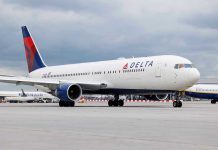
Four critical bolts meant to secure a door panel on a Boeing 737 Max were never installed, leading to a catastrophic mid-flight blowout that could have ended in mass casualties.
Key Takeaways
- NTSB investigation revealed systemic failures across Boeing, Spirit AeroSystems, and FAA oversight led to the Alaska Airlines door plug blowout in January 2024.
- Four critical bolts securing the door panel were removed and never reinstalled during manufacturing, a fundamental oversight that went undetected.
- Boeing workers reported feeling pressured and unqualified for tasks, while Boeing’s internal audits, employee reports, and quality alerts identified problems that were repeatedly ignored.
- The incident follows Boeing’s troubled history with the 737 Max, which was previously grounded worldwide after two fatal crashes in 2018 and 2019.
- Boeing and Spirit AeroSystems are now redesigning the door plug with a backup system, expected to be certified by 2026, while the FAA has capped 737 Max production at 38 jets monthly.
NTSB Exposes Critical Manufacturing and Oversight Failures
The National Transportation Safety Board has identified a chain of catastrophic failures that led to a door panel blowing out during Alaska Airlines flight 1282 in January 2024. The incident, which occurred shortly after takeoff from Portland, Oregon, caused a dangerous vacuum within the cabin and minor injuries to eight passengers. Investigators found that four bolts critical to securing the door plug panel were removed during assembly at Boeing’s manufacturing facility and never reinstalled – a fundamental oversight that should have been caught by multiple quality control processes.
“The truth is, there was a long chain of events that led to the door plug departure. Problems were identified in numerous Boeing internal audits across production lines, employee speak-up reports, quality alerts, and regulatory compliance issues,” said Jennifer Homendy, NTSB Chairwoman at a June 24 hearing.
A Culture of Production Pressure Over Safety
The NTSB investigation uncovered a troubling culture at Boeing where workers reported feeling pressured to meet production targets and often found themselves assigned to tasks for which they felt unqualified. This culture prioritized speed over thoroughness, compromising safety at multiple levels. The regulatory oversight framework that should have caught these issues also failed spectacularly, with the FAA’s inspection system proving inadequate to identify the systemic manufacturing problems that had become pervasive throughout Boeing’s operations.
“We at Boeing regret this accident and continue to work on strengthening safety and quality across our operations,” stated Boeing, in response to the NTSB findings.
The incident represents yet another black mark for Boeing’s troubled 737 Max program, which was previously grounded worldwide after two fatal crashes in 2018 and 2019 that killed 346 people. Those disasters were linked to flawed flight control systems, while this latest incident exposes fundamental issues in manufacturing processes and quality control – suggesting the problems at Boeing run far deeper than previously acknowledged.
Regulatory Failures and Promised Reforms
The NTSB report points to significant failures within the FAA’s oversight framework, which allowed these manufacturing defects to persist undetected. In response to these findings, the FAA has implemented more aggressive oversight measures, including weekly meetings with Boeing to review progress and challenges. The agency has also capped Boeing’s 737 Max production at 38 jets per month until substantial safety improvements can be verified and maintained consistently.
“[The FAA] has fundamentally changed how it oversees Boeing since the Alaska Airlines door-plug accident and we will continue this aggressive oversight to ensure Boeing fixes its systemic production-quality issues. We are actively monitoring Boeing’s performance and meet weekly with the company to review its progress and any challenges it’s facing in implementing necessary changes,” stated the FAA.
Boeing and Spirit AeroSystems are now redesigning the door plug with a backup retention system, expected to be certified by 2026. The NTSB has urged retrofitting all existing 737 Max planes with these improved panels. Boeing has also hired a new CEO and created a senior vice president of quality position to enhance manufacturing practices and rebuild its damaged safety reputation. However, the persistent nature of these problems raises serious questions about whether these changes will be sufficient.

















